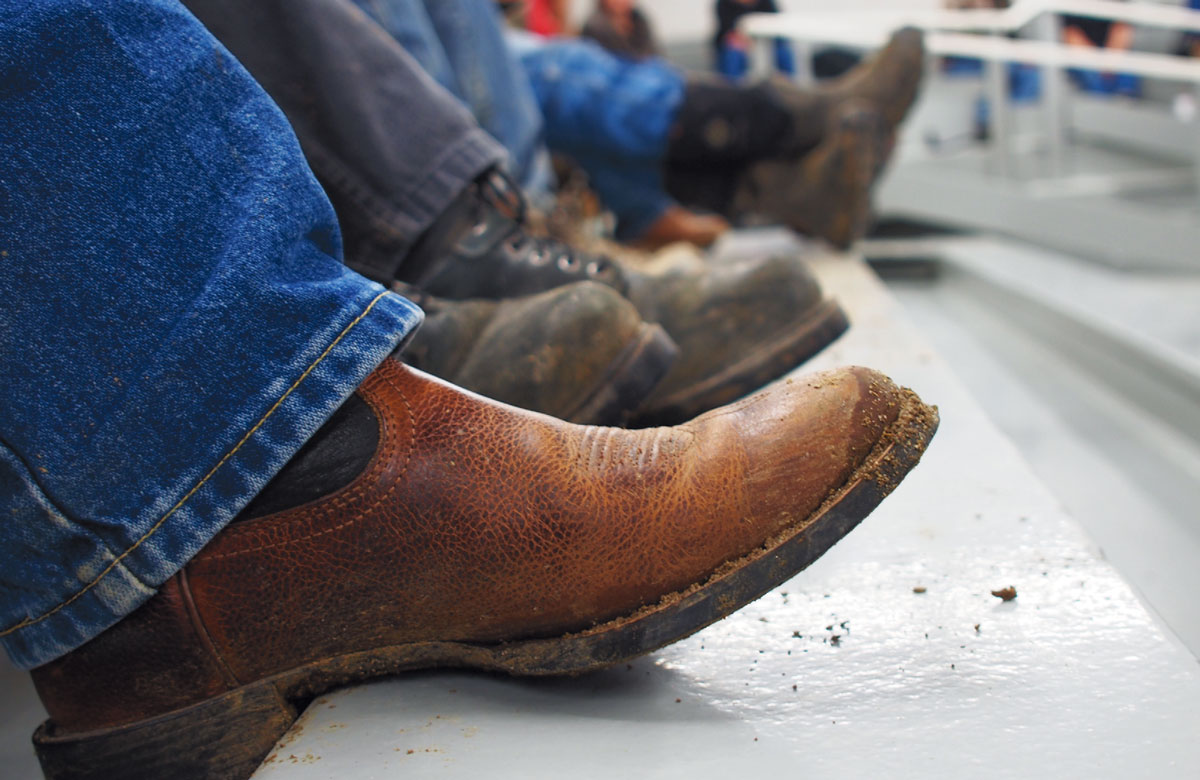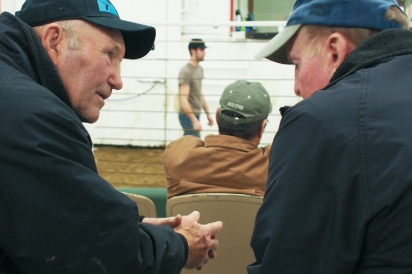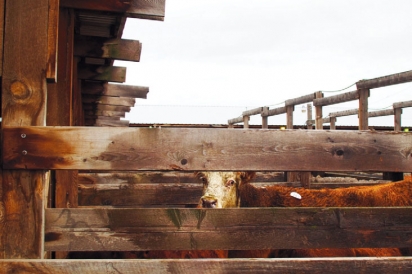The Last Roundup
Old ways linger at Caldwell cattle auction
“Cows ain’t selling good today,” says a man wearing brown coveralls standing at the urinal next to me in the restroom of the Treasure Valley Livestock Auction in Caldwell, Idaho.
“Why’s that?” I ask.
“Not enough people, could be. Or the rain, could be. Could be the season, could just be.”
The man finishes his business and exits the restroom. If what he told me was true— and if I was in the market for cattle—today would be a good day to buy. But instead, I’m here to meet with a retired cattleman named Leo Sommer, who, like me, is here for purposes all his own.
Sommer sits in the middle-aisle of the auditorium’s gray bleachers watching three Hereford calves scuttle around the high-fenced ring as the auctioneer’s low-pitched call plays through loudspeakers at either side of the auction booth.
Sommer is 84 years old, the son of Norwegian immigrants who came to Idaho in the 1930s. He’s been working and living around cattle for well over six decades. Though he’s retired now, Sommer comes to these auctions to meet with old friends. I introduce myself and take a seat on the bleacher behind him. A man named Don Nonella sits next to Sommer. Nonella’s a bit younger than Sommer, big and stocky with a large, bald head. Nonella does most of the talking.
“Did you hear the story about Dick?” he asks.
“I heard a lot of stories about Dick. Don’t know if I heard that one,” says Sommer. Nonella tells Sommer the story. When the story’s finished, Sommer nods his head once.
“Sounds like Dick,” he says.
The bleachers are half full and the majority of the 150 attendees are men above the age of 50. A small contingent of serious bidders sit in padded seats around the ring, signaling their bids with gestures discernible only to the auctioneer and a few auction veterans. Most other attendees sit on the wooden bleachers above, paying more attention to their own conversations than the bidding on the floor.
Sommer tells me these auctions used to be populated with families who’d come to celebrate a mix of community and commerce, but the decline of small markets has made this an event for a subculture of old cowhands. Thirty years ago, weekly cattle auctions were big in any Idaho town with a population above 500 people. Now only eight exist in the entire state, populated by a breed of westerner on the verge of extinction.
Sommer experienced the decline of Idaho’s small livestock markets firsthand. His career in the cattle industry began in 1954, when he took a job with an order-buying company in Middleton and later became a company partner, purchasing cattle at auction for meat processing companies and renting space on feedlots to raise the cattle to desirable weights.
Back then, the nation’s livestock was raised on small farms and ranches, and feedlots held just a few hundred head of cattle. But in the 1980s, mega-feedlots capable of handling up to 150,000 cattle drove smaller businesses out of the market. Today, according to the National Cattlemen’s Beef Association website, 80% of the nation’s cattle are fed on just 5% of all feedlots.
In 1984, Sommer’s company ceased operations. Sommer followed the industry to Smith Valley, Nevada, where he began work at an integrated livestock operation that raised, fed, processed and sold beef to casinos. Sommer managed the company’s feedlot and was responsible for 1,500 to 2,000 cattle at any given time. He retired in 2009, and now lives with his second wife in an RV parked on his son’s farm outside Middleton. His life has been a full-circle return to the land where he was raised. At this point, the auction is Sommer’s only social outlet beyond his family on the farm.
Another old friend, Charlie Kendall, recognizes Sommer and takes a seat. The two shake hands as two mid-sized Angus heifers are brought into the ring. The cattle are weighed by a scale under the ring and the measurement is displayed on a screen just to the left of the auction booth. The head count and current bid are on the screen, too. A man in the booth operates a computer next to the auctioneer, entering bid information that is instantly made available to the crowd.
“Used to be you had to know everything about the cattle before you made a bid, back when it was done on paper,” says Sommer.
Before the introduction of computers to these auctions, a bevy of secretaries and bookkeepers worked long hours creating paper trails of transfers of cash and cattle in bills of sale and receipts. All this paperwork meant that an auction beginning at 9am might not wrap up until 10pm, with people bustling around the yard loading livestock into trucks and getting their books in order. Now all sales are performed online, and cattle can be loaded onto trucks within minutes of a winning bid. When today’s auction ends, the auction yard will be all but empty within an hour.
Kendall and Sommer are talking about the health of someone they’ve both known for years. They agree that the person’s healthier than he’s been for a while, but that he’s getting pretty lonely. They both look to the ring, where a Charolais bull has begun bucking and charging at the ring-men, who seek shelter behind the metal guards made for this purpose. The auctioneer’s call is silenced and conversations in the crowd cease. For a moment, the only sounds are the bull’s grunts and the thud of hooves hitting dirt.
“All right,” the auctioneer laughs, “let’s send it out!”
The gate opens, and the bull exits the ring. Bidding continues in the bull’s absence, and a sale is made. The ring-men seem unperturbed by the incident. One of them appears to be about 30 years old, and he might be the youngest male present. As soon as I make this observation, two young men in cowboy hats stand up and make their way toward the auditorium’s doors.
“Levi, where you going?” says the auctioneer through the public address system.
“Home,” yells one of the young men.
“You get straight home, then. No stoppin’ off. Hear me?” adds the auctioneer.
The young men both nod and leave. A few more sales take place, and the rest of the crowd begins to disperse. Besides a few stragglers, only the serious bidders remain in their seats.
“Pretty much over,” says Sommer.
Though Sommer is talking about today’s auction, its hard not to hear something else in his words. Today, the nation’s major cattle auctions are performed via live-feed recordings, and bidders at mega-ranches need to know more about computers and grid-equations than they do about cattle to remain successful in the industry. For events like the Treasure Valley Cattle Auction, the future is uncertain. Will the auctioneer’s booth someday be replaced by a screen? Or will a resurgence in community-based agriculture make these markets the social events they once were—and still are—for people like Sommer?
A final bid is made, and the auction comes to a close. The auctioneer sincerely wishes everyone a Merry Christmas, and the screen next to his booth fades to black.







